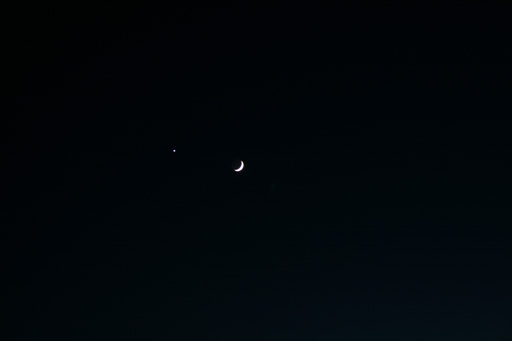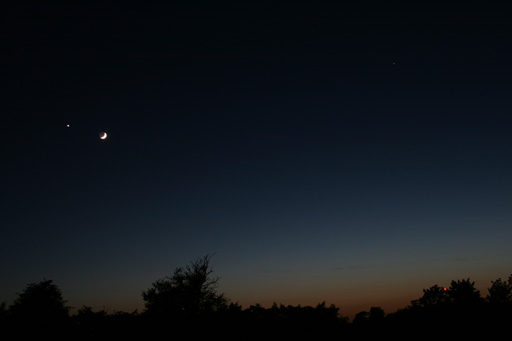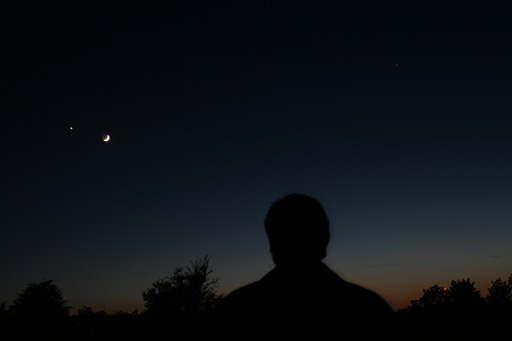|
A short while after we'd set the 'scopes up and left them to cool
down we were joined by a young couple asking what we were looking
at. We explained that we weren't looking at anything specific and
asked them if they wanted to have a look through the 'scopes.
Over the next 20 minutes or so we gave them a tour of
Venus, the Moon and
Saturn. As usually happens Saturn seemed to go
down a treat.
While showing them Saturn I noticed that the image wasn't too good
this evening. It was possible to make out the planet's shadow on
the rings but that was about all that could be seen. I couldn't
make out the Cassini Division.
Venus was also a bit of a problem too. While it was possible to
make out the phase (it was apparent that the phase was smaller
than the last time
I observed it) there was a lot of false colour (the
contrast booster helped a little but
not as much as it has in the past) and the image was very
unsteady.
|
|
Just after the first guests left we had another visit. This person
didn't stay very long, just long enough to have a quick look at
Saturn through Kevin's ETX125. That sight got a
very obvious "wow!" (as it does with most people).
|
|
I got the Canon EOS 400D out of the car,
set it on the tripod, and took some wide angle views of
Venus and the Moon
together:



|
|
By 21:37 UT it was obvious that it was going
to be a very damp observing session. I noticed that lots of dew
was forming on everything. I covered up the log book and anything
else that might suffer from getting wet and decided to stop for a
short coffee break.
|
|
John had got M51 in his 80mm 'scope and I had a
look at it (I would have got it in the 905
too but it was in a position that I can't get that 'scope in to
— it's not very good at pointing almost overhead). At first
it was difficult to see but, slowly, a very faint ghostly patch
came into view using averted vision. I was
impressed that I could see anything given that the sky still
wasn't anywhere near fully dark.
|
|
Given that Lyra was at a reasonable hight I decided
to see how M57 looked in the
905. I found it without too much trouble
using the 25mm eyepiece (in that it simply
looked like a slightly out-of-focus star) and I then switched to
the 6mm eyepiece
With the 6mm it simply looked like a faint disc. There was no hint
of the ring structure that I've seen before in the
130M.
Given that the sky still wasn't fully dark I decided to compare
the view I had with the view using the Neodymium filter. It did appear to improve
things slightly although I wouldn't have said that it brought out
any more detail. While I wasn't really comparing like-for-like in
terms of observing conditions I'm of the impression that this is
an object better left to the 130M.
|
|
By 22:16 UT I noticed that the
905 was starting to fog up. Because of this
I decided to cover it up and see if it would clear.
|
|
While the 905 was recovering I had a look
at M3 thought Kevin's ETX125. For some reason
I've never observed this cluster globular cluster
before. I was surprised at how striking the view was.
Observing with a 15mm eyepiece, at first all I could see was a
diffuse patch in the sky. As my eye adjusted, and especially when
using averted vision, I started to see a mottled
effect in the cluster and I soon had the first distinct impression
that I was making out individual stars.
|
|
After a short coffee break we noticed that
Jupiter was visible between trees, low on the
horizon. Kevin turned his ETX125 onto it and I spent a short while
having a look. All four moons were visible, one to one side of the
planet and three to the other side. The view, however, was
terrible. It was impossible to make out any detail whatsoever on
Jupiter. This wasn't really that surprising given that the planet
was so low down and also given that we were observing it thought
some thin (and apparently growing) cloud.
|
|
I uncovered the 905 and turned that towards
Jupiter. Using the 6mm
eyepiece and the contrast
booster the view was no better than it had been via the
ETX125. I spent a short while just observing but the view never
improved and I never saw any detail at all on the planet. At no
point could I even make out the two main bands.
|
|
Over the past ½ hour or so more and more thin cloud had
been forming over is and was starting to spread out more. By
around 23:41 UT it was obvious that it
wasn't going to get any better so we decided to call an end to the
session.
|


